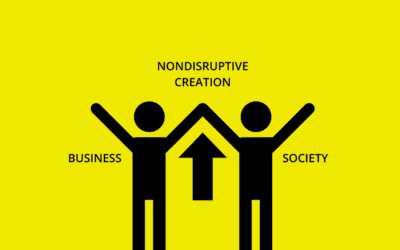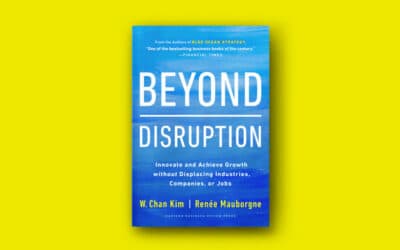YouTube, Twitter, Facebook, Wikipedia, smartphones. Can’t imagine your life without these. Right?
Yet none of these existed just a stone’s throw back. In the past decade, the world has changed in significant ways, with dramatic shifts in almost everything we do. These shifts have profound implications on the world of strategy.
Whether organizations operate in the private sector, the public sector, or the non-profit sector and whether they are based in America, Europe, Asia or any place else on earth, there is a growing challenge to rethink the strategies driving our organizations. There is a rising need for organizations of every stripe to simultaneously pursue differentiation to stand out in the market and low cost in what they do.
That’s what we call ‘value innovation,’ the cornerstone of blue ocean strategy.
Here are four trends that make creating blue oceans that much more relevant and important to you.
Trend 1: A rising call for creative new solutions
Just look at a broad swath of industries that matter fundamentally to who we are: health care, K-12 education, universities, financial services, energy, the environment, and the government, where demands are high yet money and budgets are low. In the last ten years, every one of these industries has been seriously called to task.
There has hardly been a time in history when the strategies of players in so many industries and sectors needed fundamental rethinking. To remain relevant, all these players are increasingly being called on to reimagine their strategies to achieve innovative value at lower costs.
Healthcare, for example, has seen its costs rise more than 60% in the past 10 years, yet the level of care has gone down. Similarly, while cost of K-12 education has skyrocketed in the past decade with the US is now the fourth-highest spender on K-12 education per student, the US’s standing on global rankings has dropped to 22nd among 27 industrialized nations.
Trend 2: The rising influence and use of public megaphones
It’s hard to believe, but only ten years back, organizations still controlled the majority of information disseminated to the public on their products, services, and offerings. Today that’s history.
The surge in social network sites, blogs, micro-blogs, video-sharing services, user-driven content, and internet ratings that have become close to ubiquitous around the globe have shifted the power and credibility of voice from organizations to individuals.
Today buyers and the public know, they assess, they broadcast their opinions, and they connect. Facebook now has more than 1.4 billion users who connect and share their experiences, likes, dislikes, and ideas every day. Ten years ago Facebook was only just taking off. Or take Twitter, nonexistent ten years back, yet today it has over 300 million monthly active users sharing what’s hot, what’s not, and why.
To not be a victim but a victor in this new reality, your offering needs to stand out as never before. That’s what gets people tweeting your praises, not your faults, giving five-star ratings; clicking the thumbs up, not the thumbs down; listing your offering as favorites on social media sites; and even being inspired to positively blog about your offering. You can’t hide or overmarket your me-too offering when virtually everyone has a global megaphone.
Trend 3: A locational shift in future demand and growth
When people around the world talk about the growth markets of the future, Europe and Japan hardly get a mention these days. Even the United States, though still the largest economy in the world, has increasingly taken a backseat in terms of future growth prospects. Instead, today China and India, not to mention countries like Brazil, top the list. There is a reason.
In the last ten years, China’s economy leapt from the tenth to the second-largest economy in the world. India too has joined the list of the top ten largest economies. And in the last ten years Brazil joined the ranks of this elite and influential club, and now holds the place of the sixth-largest economy in the world.
However, this new breed of big economies is not like the large economies the world has historically looked to and counted on to consume the goods and services produced by the world. Unlike the relatively high per capita incomes enjoyed in the world’s developed economies, these big emerging markets are the product of very low, though rising, per capita income for very large populations of citizens.
This makes the importance of affordable low cost in organizations’ offerings more critical than before. Without this, companies will not be able to unlock, for the foreseeable future, the consumption power and potential demand of China’s 1.3 billion, India’s 1.2 billion, and Brazil’s 197 million inhabitants.
But do not be fooled. Low cost alone is not enough. For these same large populations also have increasing access to the internet, mobile phones, and TVs with global channels that raise their sophistication, demands, and desires. To capture these increasingly savvy customers’ imaginations and wallets, both differentiation and low cost are needed.
Trend 4: The rising speed and easiness of becoming a global player
Historically, the major global companies came predominantly from the United States, Europe, and Japan. But that is changing at incredible speed. Over the last fifteen years, the number of companies from China in the Fortune Global 500 has increased more than twenty times, the number of Indian companies has increased roughly eightfold, and the number of Latin American companies more than doubled.
This suggests that these big emerging economies do not only represent oceans of new demand to unlock. They also represent oceans of new potential competitors with global ambitions no different than Toyota’s, General Electric’s, or Unilever’s.
But it’s not just companies from these big emerging markets that are on the rise. That is just a tip of the iceberg of what the future portends. In the last decade, there has been a fundamental shift in the cost and ease of becoming a global player from virtually any corner of the globe. This is a trend no organization can afford to downplay.
Consider just a handful of facts. With the ease and low cost of setting up a website, any business can have a global storefront; today people from anywhere can raise money via crowdfunding; with services like Gmail and Skype, communication costs have dropped significantly; trust in transactions can now be rapidly and economically achieved by using services like PayPal, while companies like Alibaba.com make searching for and vetting suppliers across the world relatively quick and easy.
And there are search engines—the equivalent of global business directories—that are free. As for global advertising, there is Twitter and YouTube where you can market your offerings for free. With the low entry cost to become a global player, new players from virtually all corners of the world can increasingly participate in global markets and offer their wares or services.
While, of course, these trends don’t mitigate all barriers to becoming a global player, they certainly intensify global competition. To stand apart in these overcrowded markets, you need to be creative through value innovation.
Today both the challenges and opportunities we all face are great. These four trends, however, need not be deadly. They can be a huge opportunity for those who don’t ask “should we?” but ask “how can we?” create blue oceans.
Strategy, after all, is not just for business. It is for everyone—the arts, nonprofits, the public sector, even countries. One thing is clear: the world needs blue oceans.

















